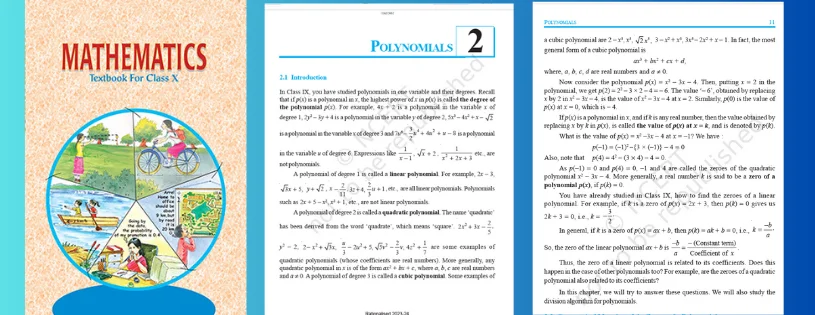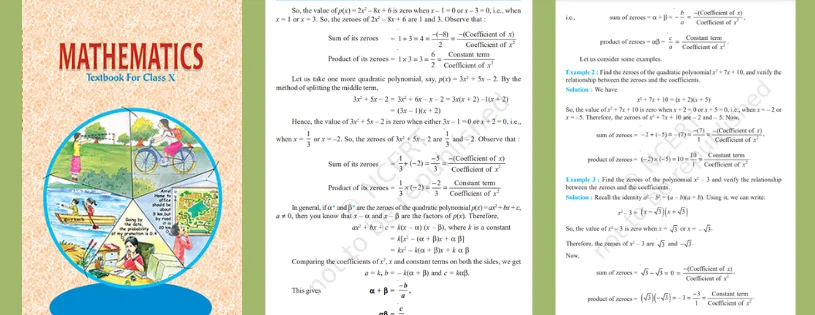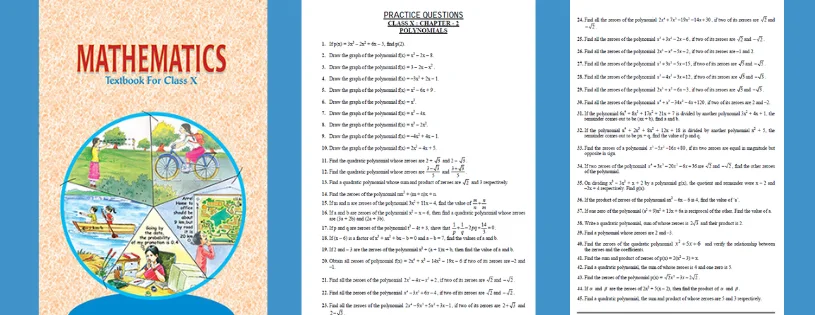In the realm of mathematics, polynomials play a pivotal role. These algebraic expressions, comprising variables and coefficients, are not only fundamental but also find extensive applications in various fields. Chapter 2 of Class 10 Mathematics delves into the world of polynomials, unraveling their properties, operations, and practical implications.
Class 10 Mathematics (CBSE NCERT) – Chapter 2 Class Polynomials
Polynomials are algebraic expressions that consist of variables and coefficients. Variables are also sometimes called indeterminates. We can perform arithmetic operations such as addition, subtraction, multiplication, and positive integer exponents for polynomial expressions but not division by variable.
Defining Polynomials:
-
Understanding Expressions:
- Polynomials are algebraic expressions involving variables, coefficients, and exponents, comprising a sum of terms.
-
Degree of Polynomials:
- The degree of a polynomial is the highest power of the variable within the expression. It determines the overall behavior and characteristics of the polynomial.
Basic Operations:
-
Addition and Subtraction:
- Combining or subtracting polynomials involves adding or subtracting corresponding terms, simplifying the expression to its most concise form.
-
Multiplication:
- Multiplying polynomials requires the application of distributive property, where each term of one polynomial is multiplied by each term of the other.
-
Factoring:
- Factoring involves expressing a polynomial as the product of its factors, simplifying complex expressions and aiding in solving equations.

Download Mathematics notes
Understanding Polynomials
Definition: A polynomial is an algebraic expression consisting of variables (or indeterminates) and coefficients, combined through addition, subtraction, and multiplication, but not division by a variable. The general form of a polynomial is given by:
0P(x)=anxn+an−1xn−1+…+a1x+a0
Here, -0an,an−1,…,a1,a0 are coefficients, x is a variable, and n is a non-negative integer representing the degree of the polynomial.
Polynomials are classified based on their degree
Linear Polynomial: P(x)=ax+b, where a and b are real numbers, and a is not equal to zero.
Quadratic Polynomial: P(x)=ax2+bx+c, where a, b, and c are real numbers.
Cubic Polynomial: 2+ P(x)=ax3+bx2+cx+d, where a, b, c, and d are real numbers, and a is not equal to zero. a is not equal to zero.
practical Applications:
-
Geometry:
- Polynomials are utilized in geometry for expressing formulas related to area, volume, and perimeter.
-
Physics:
- The motion of objects and the modeling of physical phenomena often involve polynomial equations.
-
Economics:
- Polynomial functions play a role in economic modeling, particularly in scenarios involving supply and demand curves.
Polynomials in Equations:
-
Solving Equations:
- Polynomials are essential in solving equations, where factoring or using methods like the quadratic formula helps find the roots.
-
Graphical Representations:
- The graph of a polynomial provides a visual representation of its behavior, aiding in understanding its characteristics.
CBSE Class 10 NCERT Mathematics Topics for a Strong Foundation (NCERT DOWNLOAD)
Here, students are introduced to several important concepts that will be useful for those who wish to pursue mathematics

CBSE Class 10 Board Exam Sample Paper

Download Question Bank
[Previous Year Question Solution Maths Download Button]
[Previous Year Question Solution Science Download Button]
CBSE Class 10th Downloadable Resources:
Being in CBSE class 10th and considering the board examinations you must be needing resources to excel in your examinations. At TestprepKart we take great pride in providing CBSE class 10th all study resources in downloadable form for you to keep you going.
Below is the list of all CBSE class 10th Downloads available on TestprepKart for both Indian and NRI students preparing for CBSE class 10th in UAE, Oman, Qatar, Kuwait & Bahrain.
FAQ
Q1 How are polynomials classified?
Ans: Polynomials are classified based on their degree. The classifications include linear, quadratic, cubic, and so on. A linear polynomial is of degree 1, a quadratic polynomial is of degree 2, and a cubic polynomial is of degree 3.
Q2 How is polynomial multiplication performed?
Ans: Polynomial multiplication involves applying the distributive property to multiply each term of one polynomial by each term of the other. The resulting polynomial's degree is the sum of the degrees of the multiplied polynomials.
Q3 Why is factorization important in polynomials?
Ans: Factorization is crucial in polynomials as it involves expressing a polynomial as the product of its factors. This process is essential for solving polynomial equations and understanding the roots of the polynomial.
Q4 Why are polynomials important in mathematics?
Ans: Polynomials are fundamental in mathematics as they serve as the foundation for various advanced concepts. They find applications in diverse fields such as physics, engineering, and computer science.
Q5 What is the significance of the leading coefficient in a polynomial?
Ans: The leading coefficient is the coefficient of the term with the highest power of the variable. It affects the behavior of the polynomial, particularly its end behavior as �x approaches positive or negative infinity.
.webp)
.webp)
Post a Comment